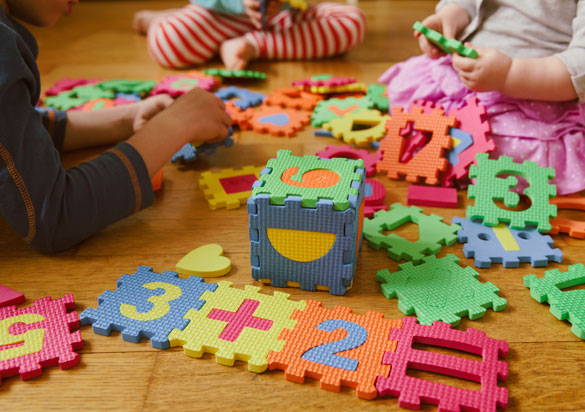

In your Transitional Kindergarten (TK) classroom, mathematics can be taught—and discovered—in the everyday environment of your young learners. For example, students can learn new concepts and relationships of numbers and quantities as they recite numbers in order, count objects, or visually compare groups of objects and express if they are the “same” or “more.” They can learn about measurement by comparing the length, weight, or capacity of objects by using words such as bigger, longer, heavier, or taller. Young children learn these important foundations of mathematics while engaging in imaginative play, exploring the environment and materials, making discoveries, or interacting with teachers or other adults.
“Mathematics learning at this level must be active, rich in natural and mathematical language, and filled with thought-provoking opportunities. Students respond to the challenge of high expectations and mathematics should be taught for understanding rather than around preconceptions around children’s limitations. This does not mean abandoning children’s ways of knowing and representing; rather it is a clear call to create opportunities for young students to learn new, important mathematics in ways that make sense to them.”1
Instructional time in TK should focus on the following content:2
As a teacher, you can foster the development of early mathematical skills by providing environments rich in language, where thinking is encouraged, uniqueness is valued, and exploration is supported. Teachers support young children’s diligence and mathematical development when they direct attention to the math children use in their play, challenge them to solve problems, and encourage their persistence. It is also important to incorporate strategies that connect new words with concept development for children who are Dual Language Learners (DLLs), aligning their English language development goals with support for the development of mathematical language and ability.
Encourage children’s strategies and build on them as ways of developing more general ideas and systematic approaches. By asking questions that lead to clarifications, extensions, and the development of new understandings, you can facilitate children’s mathematics learning. Ensure interesting problems and stimulating math conversations are a part of each day, and mathematical concepts are integrated throughout all learning centers. It is also important to honor individual children’s thinking and reasoning and use formative assessment to plan instruction that allows your students to connect new math skills with what they know.
It is imperative to provide all students with high-quality math instruction in a way that respects both mathematics and the nature of young children. This instruction should build on and extend students’ intuitive and informal mathematics knowledge and should take place in environments that encourage students to be active learners and accept new challenges.


The following principles can provide guidance for effective classroom practices in supporting early math development: (Adapted from the California Preschool Foundations Curriculum Framework Volume 1, 2010, p. 233-236)
The teaching strategies below give concrete approaches for mathematics instruction in your classroom. They are designed to guide developmentally appropriate TK instruction, moving your students along a continuum of learning by bridging the Preschool Learning Foundations with the Kindergarten Common Core.
Strategy 1: Number Sense of Quantity and Counting
Strategy 2: Number Sense of Mathematical Operations
Strategy 3: Measurement
Strategy 4: Shapes
Strategy 5: Patterning
Strategy 6: Problem Solving
Strategy 7: Classification
Strategy 8: Integrated Approaches for English Language Development and Family Engagement
Click the button below to download the teaching strategies (PDF).
| 1 | NCTM Principles and Standards for School Mathematics, 2000, p. 77 |
| 2 | Adapted from NCTM Curriculum Focal Points and Connections for Prekindergarten and Kindergarten |